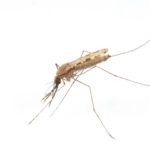Link to Pubmed [PMID] – 30874601
Link to DOI – 10.1038/s41598-019-41094-4
Sci Rep 2019 03; 9(1): 4669
Human malaria, which remains a major public health problem, is transmitted by a subset of Anopheles mosquitoes belonging to only three out of eight subgenera: Anopheles, Cellia and Nyssorhynchus. Unlike almost every other insect species, males of some Anopheles species produce steroid hormones which are transferred to females during copulation to influence their reproduction. Steroids are consequently a potential target for malaria vector control. Here, we analysed the evolution of sexually-transferred steroids and their effects on female reproductive traits across Anopheles by using a set of 16 mosquito species (five Anopheles, eight Cellia, and three Nyssorhynchus), including malaria vector and non-vector species. We show that male steroid production and transfer are specific to the Cellia and therefore represent a synapomorphy of this subgenus. Furthermore, we show that mating-induced effects in females are variable across species and differences are not correlated with sexually-transferred steroids or with Anopheles ability to transmit human malaria. Overall, our findings highlight that Anopheles mosquitoes have evolved different reproductive strategies, independently of being a malaria vector or not.


